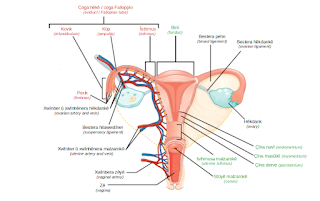Endometritis is inflammation of the inner lining of the uterus which is generally caused by infection. This condition is more at risk for women who have had a caesarean section or curette. Endometritis needs to be treated immediately to prevent impaired fertility and the spread of infection to other organs.
 |
| Endometritis, Causes, Diagnosis, Treatment, Prevention, Complications |
Endometritis is different from endometriosis. Endometriosis is a condition when cells from the endometrium, which is the inner lining of the uterus, grow outside the uterine wall. While endometritis is an infection or inflammation of the endometrium. Although different, both conditions can cause infertility.
Causes of Endometritis
Basically, the uterus is a sterile organ. Endometritis occurs when bacteria enter the uterus and infect it. Types of bacteria that cause endometritis include Bacteroides, Peptococcus, Streptococcus, Enterococcus, E. coli, Gardenella vaginalis, and Staphylococcus aureus.
Endometritis generally occurs due to the entry of bacteria into the uterus during labor or after delivery. Some other conditions that can cause endometritis are:
- Sexually transmitted diseases, such as chlamydia or gonorrhea
- Spread of infection from bacterial vaginosis
- Spread of tuberculosis infection leading to prolonged (chronic) endometritis
Endometritis risk factors
As mentioned above, endometritis occurs when bacteria enter the uterus. A number of factors that can increase the risk of this event are:
- Delivery by caesarean section, because the uterus can come into contact with air or other factors outside the body
- Medical procedures that involve the use of a device that is inserted through the cervix, such as hysteroscopy, placing spiral contraception, and curettes
- Untreated premature rupture of membranes or prolonged labour
- Postpartum bleeding
- Infection of the amniotic sac (chorioamnionitis)
- Endometrial biopsy, which is taking a tissue sample from the lining of the uterus
- Placenta or tissue left in the uterus after delivery or as a result of a miscarriage
Endometritis symptoms
Endometritis can cause a variety of symptoms. Common symptoms of endometritis include:
- Fever
- Abdominal swelling
- Pain in the lower abdomen, pelvic area or rectum
- Abnormal vaginal discharge
- Bleeding from the vagina outside of menstruation
- Pain when defecating
- Constipation
- Feeling unwell and weak
When to see a doctor
Check with your doctor if you experience the above symptoms. You should immediately seek medical help if symptoms of endometritis appear, especially after childbirth, miscarriage, installation of spiral birth control, operations on the uterus, and curettes.
Endometritis diagnosis
To diagnose endometritis, the doctor will ask about the patient's symptoms, medical history, and history of childbirth or uterine surgery. After that, the doctor will carry out a physical examination, including a pelvic examination.
Furthermore, to make a diagnosis, the doctor can carry out further examinations in the form of:
- Blood test, to check for signs of infection in the form of an increased white blood cell count
- Examination of fluid samples from the cervix (cervix), to detect endometritis-causing bacteria
- Endometrial biopsy, to take samples of endometrial tissue which will then be examined in the laboratory
- Laparoscopy, to see the inside of the stomach so the doctor can detect signs of infection more clearly
Endometritis Treatment
Endometritis treatment depends on the cause and severity. If endometritis occurs after delivery, the patient will be given intravenous antibiotics and asked to be hospitalized.
The types of antibiotics that doctors can give are clindamycin, gentamicin, and ampicillin. Doctors can give one or a combination of these three antibiotics.
In endometritis with mild symptoms caused by other conditions, the doctor will give antibiotics to drink. If endometritis is caused by a sexually transmitted disease, the doctor will also treat the patient's partner.
Endometritis complications
Endometritis that is not treated quickly and appropriately can cause serious complications in the form of:
- Infertility
- Pelvic peritonitis, which is a severe infection of the pelvic cavity
- Abscess of the uterus or pelvis
- Sepsis
- Septic shock
Prevention of Endometritis
To prevent endometritis, doctors will give antibiotics before and after curettage, caesarean section, or labor that lasts a long time.
You can also reduce the risk of developing endometritis independently, by making the following efforts:
- Implement healthy sexual relations
- Undergo regular screening for sexually transmitted diseases
- Finish the antibiotics prescribed by the doctor if suffering from sexually transmitted diseases
- Undergo routine pregnancy control
- Carry out routine control if undergoing spiral KB installation
Related Searches:
- chronic endometritis,
- endometritis symptoms,
- endometritis treatment,
- endometritis vs endometriosis,
- chronic endometritis treatment,
- postpartum endometritis,
- endometriosis vs endometritis,
- endometritis signs and symptoms,
- medication for endometritis,
- medicine for endometritis,
- what does endometritis mean,
- endometritis icd 10,
- postpartum endometritis symptoms,
- endometritis postpartum,


